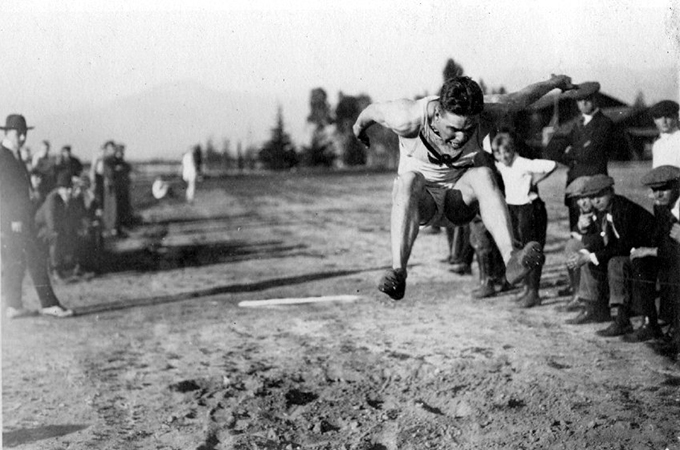University of Redlands History Professor Matthew Raffety helped out the Bulldog Blog by sharing some fun facts about the history of collegiate sports. How much do you know about the topic? Find out with this #URBrainteaser!
QUESTIONS
(Scroll down for answers.)
1. When did collegiate sports begin?
a. 1690s
b. 1750s
c. 1850s
d. 1910s
2. In the early days of football, when there weren’t enough University of Redlands students to play on a team, who filled in so a game could take place?
a. Faculty
b. Parents
c. Players for hire
d. Volunteers from the community
3. Why was the first intercollegiate football conference established in 1906?
a. To make the games safer
b. To have more teams to compete against
c. To prevent paid athletes from participating
d. To make money for the colleges
4. What was a key reason the Southern California Intercollegiate Athletic Conference (SCIAC) was launched in 1915?
a. To make the games safer
b. To have more teams to compete against
c. To prevent paid athletes from participating
d. To make money for the colleges
5. Which colleges were founding members of the SCIAC?
a. University of Redlands
b. Chapman University
c. University of La Verne
d. All of the above
6. From the early to mid-20th century, which sports were seen as most socially acceptable for women?
a. Polo and rowing
b. Tennis and golf
c. Swimming and track
d. Soccer and baseball
7. What event(s) helped launch women’s sports programs in universities across the country?
a. WWII
b. The Cold War
c. The passage of Title IX
d. B and C
e. All of the above
8. Which decade saw the biggest growth of sports facilities on university campuses?
a. 1970s
b. 1980s
c. 1990s
d. 2000s
ANSWERS
1. When did collegiate sports begin?
C) Raffety notes collegiate sports began in the early 1850s. At first, classes instead of schools played against each. The first recorded football game between schools was Rutgers versus Princeton in 1876. Back then, college football had very different rules, and each school played different versions of the sport.
2. In the early days of football, when there weren’t enough University of Redlands students to play on a team, who filled in so a game could take place?
A) In addition to organizing the sports program, it was fairly common for faculty to compete as “students” during football games.
3. Why was the first intercollegiate football conference established in 1906?
A) An intercollegiate conference was established in 1906 to make football safer, says Raffety; it would become the forerunner of the National Collegiate Athletic Association (NCAA) and formed the foundation of the modern sport. Before this time, football, which was played without protective equipment, was dangerous and bloody. In 1904, there were 18 football deaths and 159 serious injuries from the collegiate sport.
4. What was a key reason the Southern California Intercollegiate Athletic Conference (SCIAC) was launched in 1915?
C) “[These organizations proliferated] to take better control of rapidly expanding college athletics,” says Raffety. “They sought to ensure that schools fielded teams made of actual students instead of paid ‘tramp athletes’ who often shopped their services to multiple schools even in the same year.”
5. Which colleges were founding members of the SCIAC?
A) The U of R was one of the five founding members of SCIAC, with California Institute of Technology, Occidental College, Pomona College, and Whittier College. Redlands and Occidental are the only schools with uninterrupted membership.
6. From the early to mid-20th century, which sports were seen as most socially acceptable for women?
B) “Although women’s team sports remained controversial in the mid-20th century, elite sports—especially tennis and golf—had long been exempted from concerns that sports were inappropriate for ‘respectable’ women,” Raffety says. Many female athletes in these sports were able to make a name for themselves before university programs existed.
7. What event(s) helped launch women’s sports programs in universities across the country?
D) Title IX of the Educational Amendments Act of 1972 (which mandates equal access for men and women to any program or activity that receives federal financial assistance) kicked off women’s sports programs in universities around the United States, including the University of Redlands. But it became more acceptable for female athletes to compete before then: “After 1952, when the Soviet Union began competing, the Olympics became a significant battlefield in the Cold War,” Raffety says. “The pressure to increase the overall U.S. medal count prompted more interest in (and funding for) women’s sports.”
8. Which decade saw the biggest growth of sports facilities on university campuses?
C) “In the 1990s, fierce competition for students put pressure on colleges throughout the country to build bigger and better facilities,” Raffety says. “It’s hard to display to prospective students the quality of what happens in classroom—but you can show people buildings and sports complexes.” It was around this time that new athletic facilities for softball, aquatics, soccer, and more were built at U of R and full-time coaches were hired for softball, soccer, and lacrosse.
For more on U of R athletics, see the Bulldog Athletics web pages.






